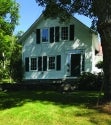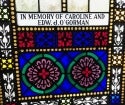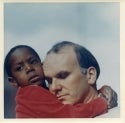Exhibit Case #1—Childhood/Family:
The O'Gorman Farmhouse
Photograph of the O’Gorman farmhouse, Bradford, Vermont, 2017. On loan, courtesy of Elizabeth Howard.
Edward Charles “Ned” O’Gorman was born in New York City on 26 September 1929 and lived in Stamford and then Southport, Connecticut, before Samuel Franklin Engs O’Gorman uprooted the family in 1942 and moved them to a farmhouse, tucked along a dirt lane in Bradford, Vermont.
Letters from Ned O'Gorman to his Mother
Letters from Ned O’Gorman to his mother, Annette O’Gorman, 26-27 March 1957 and 16 July 1985, Ned O’Gorman papers 1: box 1, folder 60.
Ned adored his mother, Annette de Bouthillier-Chavigny, and wrote her often throughout his life as he traveled. His parents divorced, Mrs. O’Gorman moved to Manhattan in 1947 and for many years lived at 56 West 11th Street. She died in 1988.
Postcard from Samuel O'Gorman to Ned O'Gorman
Postcard from Samuel O’Gorman to Ned O’Gorman, mailed from Columbia University, New York City, to Bradford, Vermont, 29 June 1942. Ned O’Gorman papers 1: box 1, folder 59.
While Ned was adored by his mother, the shy, stuttering young teenager struggled to establish a connection with his father. This postcard, with the words “From Daddy” in his own handwriting, must have had significance for Ned.
Exhibit Case #2—The Catholic Church:
Photographs from Our Lady of Perpetual Help Roman Catholic Church
Photographs from Our Lady of Perpetual Help Roman Catholic Church in Bradford, Vermont, 2017. On loan, courtesy of Elizabeth Howard.
Ned discovered a rudder to steer him toward a point of balance in his life at Our Lady of Perpetual Help Roman Catholic Church, Bradford, Vermont. The church was constructed after the O’Gormans arrived. One of the stained glass windows is dedicated to Caroline and Edward J. O’Gorman, Samuel’s parents.
Letters from John E. Doherty to Ned O’Gorman
Letters from John E. Doherty to Ned O’Gorman, circa 1953. Ned O’Gorman papers 1: box 1, folder 15.
Ned met Father John E. Doherty of the Redemptorist Fathers in Bradford, Vermont, and maintained a steady correspondence with him throughout the 1950s. Father Doherty provided encouragement and counsel to Ned as he pursued a life in New York:
“You don’t know how much strength you have Ned. It’s a great chance for you. Also a chance to bring these poor kids some idea of what life is all about.”
“You’re a creator, Ned. But the test of you’re [sic] creative power will be turning the dull, prosaic events of life into eternal spring.”
Promotional Poster for and Cover of Jubilee
Promotional poster for Jubilee, circa 1964. Ned O’Gorman papers 1: box 3, folder 30.
Cover of Jubilee, July 1964. Ned O’Gorman papers 2: box 12, folder 6.
Jubilee (1953-1968) was a Catholic literary magazine conceived by Edward J. "Ed" Rice, an author, publisher, photojournalist and painter, and founded by Robert Lax and Thomas Merton. The magazine featured bold black-and-white photography, poetry, artwork, essays, journalism and spiritual writings. Ned O’Gorman served as the magazine’s Senior Editor (1962-1965).
Letter from Daniel Berrigan
Letter from Daniel Berrigan to “Dearest friends” and supporters, Arlington, Virginia, March 1977. Includes handwritten poem, “From Arlington Jail,” and inscription to Ned. Ned O’Gorman papers 1: box 1, folder 8.
Ned maintained a friendship with Daniel Berrigan throughout his life. A group of Jesuits, led by Father Berrigan and Sister Anne Montgomery, held a monthly feast and Mass in Manhattan and Ned often attended these gatherings.
Exhibit Case #3—Poetry:
Christmas Card from Dorothy and Mark van Doren and Letter from Mark van Doren
Christmas card from Dorothy and Mark van Doren to Ned O’Gorman, December 1959. Ned O’Gorman papers 1: box 1, folder 84.
Letter from Mark van Doren to Ned O’Gorman, circa 1960. Ned O’Gorman papers 1: box 1, folder 84.
Ned was a graduate student at Columbia University (1955-1956) and studied with poet and professor of English Mark Van Doren, who counted among his students Thomas Merton and the poet Robert Lax. Ned graduated with an M.A. degree in 1956.
Letter from James F. Mathias
Letter from James F. Mathias, Secretary of the Guggenheim Foundation, to Ned O’Gorman, 17 April 1962. Ned O'Gorman papers 5: box 3, folder 4.
Ned received the first of two Guggenheim Foundation fellowships in 1962, which allowed him to travel and continue writing poetry. He would use the award to spend 12months working on a book of poetry. He began by roaming across Europe—tracing family roots in Ireland, spending weeks in London, traveling to Rome to visit the Vatican. Then he moved on to Africa, spending three months in Ethiopia and visiting his sister Annette. who was living in Cairo. African imagery begins to appear in his poetry: lions, rhinos, pots of jasmine, leather, blazing sun and deserts.
Poster for a Ned O’Gorman Reading
Poster for a Ned O’Gorman reading at King’s College, Briarcliff Manor, New York, 27 March 1965. Ned O’Gorman papers 1: box 3, folder 30.
Photograph of Ned O’Gorman
Photograph of Ned O’Gorman in New York, November 1960. Photographer unknown. Ned O’Gorman papers 2: box 12, folder 24.
Letter from Valborg Anderson
Letter from Valborg Anderson to Ned O’Gorman, 11 June 1959. Ned O’Gorman papers 1: box 1, folder 3.
Valborg Anderson (1912-1990) was a professor in the English department at Brooklyn College from the mid-1940s until 1976. Ned dedicated his book The Buzzard and the Peacock to her.
“…Remember my telegram to the boat – did you get it? – ‘Ulysses too had to build himself a home.’ You have to do whatever you decide to do with will and purpose or it won’t be a home.”
Exhibit Case #4—Poetry:
Musical Score Composed by Lucia Dlugoszewski
Musical score composed by Lucia Dlugoszewski, 1967. Ned O’Gorman papers 2: box 13, folder 10.
An original musical score written by Lucia Dlugoszewski and inscribed: “For Ned O’Gorman’s ‘Buzzard’ and ‘Peacock’ and new 1967.”
dark pearl of twilight
bosom of a whale!
snow!
Review of "The Buzzard and the Peacock"
“Ned O’Gorman Writes….‘The Buzzard and the Peacock’” by DeWitt Bell, St. Michael’s Review, 1964. Ned O’Gorman papers 1: box 3, folder 25.
The Buzzard and the Peacock was Ned’s third book of poetry. He had received the Lamont Poetry Prize of the Academy of American Poets for The Night of the Hammer, published in 1959.
“Ned O’Gorman’s new book of poetry, The Buzzard and the Peacock, is even more otherworldly than his two previous ones, less lyric, more involuted, more and more like the oranges of Hieronymous Bosch. His Thomistic worldview, his monk’s spirit and the pure colors of his language coalesce in an art that seems medieval – much as some medieval art seems modern.”
Books of Poetry
Books of poetry by Ned O’Gorman:
The Night of the Hammer (Harcourt Brace and World, Inc., 1959)*
Adam Before His Mirror, Harcourt Brace and World, Inc., 1961)**
The Harvesters’ Vase, Harcourt Brace and World, Inc., 1968)*
The Flag the Hawk Flies, Harcourt Brace and World, Inc., 1972)*
How to Put Out a Fire (Eakins Press Foundation, 1984; limited edition of 200)**
Five Seasons of Obsession: New and Selected Poems (Books & Co., 2001)**
*On loan, courtesy of Diana Pearson
**On loan, courtesy of Elizabeth Howard
Entry from "Artbook"
Entry from Artbook, a catalogue from Distributed Art Publishers (D.A.P), 2001. Ned O’Gorman papers 2: box 12, folder 19.
In 2001, Jeannette Sanger published Five Seasons of Obsession: New & Selected Poems (Books & Company, New York), an anthology of Ned’s poetry that included his early poems and unpublished new work. The introduction, by Ned Rorem, opens with the sentence: “We share the same Manhattan zip code. I used to wonder if the area were large enough to contain two such Neds.” He concludes with, “...for I deeply need Ned’s poetry. Like his name, it is part of my life.”
Exhibit Case #5—Prophetic Voices:
"Prophetic Voices" and Statement of Purpose
Prophetic Voices: Ideas and Words on Revolution (Random House, 1969), edited by Ned O’Gorman. On loan, courtesy of Elizabeth Howard.
Statement of Purpose for the Prophetic Voices Project [page 1], circa 1965. Ned O’Gorman papers 2: box 4, folder 42.
Prophetic Voices received little critical attention at the time of publication, yet the correspondence in Ned’s papers related to this effort to “offer certain alternatives to destruction” are relevant to our current global situation and are valuable for researchers thinking about “revolution.” As the book jacket proposes: “Has our world broken down? This book suggests that it has, and that to survive we need radical change in every aspect of our existence.”
Letter from Stan Brakhage
Letter from Stan Brakhage to Ned O’Gorman, January 1966. Ned O’Gorman papers 2: box 3, folder 16.
In thinking about the connection of prophecy and revolution, Ned wrote widely to people whose work he admired and whose insight might prove helpful to the book that would become Prophetic Voices. Stan Brakhage, an experimental filmmaker, suggested looking outside the world of academia to discover the nature of true revolution.
Letter from Jacob Canter and Schedule for Chile
Letter from Jacob Canter, Director, Office of Inter-American Programs, U.S. Department of State Bureau of Educational and Cultural Affairs, to Ned O’Gorman, 3 March 1965. Ned O’Gorman papers 2: box 12, folder 8.
Schedule for Ned O’Gorman’s assignment in Chile, 10-19 May 1965. Ned O’Gorman papers 2: box 12, folder 9.
Ned served as a Cultural Representative for the U. S. Department of State in Argentina, Brazil and Chile from April through May 1965. His time spent in South America put him in direct contact with “the very process of revolution,” an experience that lead him to the Prophetic Voices project.
Exhibit Case #6—Harlem
The Children's Storefront and the Ricardo O'Gorman Garden and Center
Photograph of Ned O’Gorman, Elizabeth Howard, Arthur Ashe, Tania Clark and Elsie Newburg at the Children’s Storefront, circa 1990. Photographer unknown.
Photograph of Millie Harford, Joe Simon, Jeannette Sanger, Ned O’Gorman and others at the Ricardo O’Gorman Garden and Center by Joyce Ravid, 2000.
Invitation to the Ricardo O’Gorman Garden and Center.
Photos on loan, courtesy of Elizabeth Howard.
Books by Ned O'Gorman
Books by Ned O’Gorman:
The Storefront: A Community of Children on 129th Street and Madison Avenue (Harper Colophon Books, 1970)
The Wilderness and the Laurel Tree: A Guide for Teachers and Parents on the Observation of Children (Harper Colophon Books, 1972)
The Children Are Dying (Signet, 1978)
Books on loan, courtesy of Elizabeth Howard.
In April 1966, O’Gorman began teaching in a Head Start program sponsored by the Office of Economic Opportunity at The Church of All Saints’ Poverty Program. This experience led O’Gorman to open a storefront and name it after Addie Mae Collins, one of the African American girls killed by the Ku Klux Klan in 1963. The Storefront grew into a school, eventually attracting the attention of educators and the media. O’Gorman was the head of school from 1966 through 1998.
The three books Ned wrote around his pedagogical experiences in Harlem might have been published in a compendium so others could benefit from his insights into developing an arts-based curriculum. He recognized the critical need to bring a sense of self and beauty to those who had been oppressed because of the color of their skin.
Exhibit Case #7—Circle of Friends:
Letter from Dame Janet Baker
Letter from Dame Janet Baker to Ned O’Gorman, circa 1981. Ned O’Gorman papers 1: box 1, folder 4.
Ned’s circle of friends included a varied group of writers, poets, musicians, and dancers. He corresponded for many years with famed mezzo-soprano Dame Janet Baker.
Invitation
Invitation to the home of Ned O’Gorman, circa 2000. On loan, courtesy of Elizabeth Howard.
Ned enjoyed welcoming small groups of friends to his home for dinner and other gatherings, where he could help connect those he thought should become acquainted.
Article from "Commonweal"
“My Dinners with Isaiah: the Music of a Philosopher’s Life,” Commonweal, 14 August 1998. On loan, courtesy of Elizabeth Howard.
O’Gorman’s friendship with philosopher Sir Isaiah Berlin lasted only six years, until Berlin’s death, but it was a friendship he treasured. “In December 1995, I had gotten the notion that Isaiah and Mitsuko Uschida, the colossal Japanese pianist, should meet. I brought them together in a lowly basement bar in Piccadilly. …We drank champagne, and oh, what wonderful stories I heard.”
Letter from Lincoln Kirstein and "How to Put Out a Fire"
Letter from Lincoln Kirstein to Ned O’Gorman, 6 August 1981. Ned O’Gorman papers 1: box 1, folder 40.
How to Put Out a Fire by Ned O’Gorman, Eakins Press Foundation, New York, 1984 (limited edition of 200). On loan, courtesy of Elizabeth Howard.
How to Put Out a Fire was published in a limited edition of 200 copies by Eakins Press Foundation. Ned had developed a friendship with Leslie George Katz, the founder of Eakins Press, and his wife, the poet Jane Mayhall Katz. It was through Katz that Ned met Lincoln Kirstein.
Letter from Dame Freya Stark
Letter from Dame Freya Stark to Ned O’Gorman, 1980 January 6. Ned O’Gorman papers 1: box 1, folder 77.
O’Gorman’s friendship with British explorer and travel writer Freya Stark began after he sent her a book of poetry. The two corresponded for nearly a decade.
“Dear Ned – You were in China when your last little note reached me and I am so anxious to hear that you are safely out – …. My tower is lovely and waiting for you – but this note is really to ask if you are safe.”
Exhibit Case #8—Art
Invitation to Art Show and Untitled Collages
Invitation to Ned O’Gorman art showing, October 2009. Leo J. Kasun papers: box 1, folder 1.
Untitled collages by Ned O’Gorman, 2007. Leo J. Kasun papers: box 1, folders 3-5.
Beginning in the 1980’s, Ned O’Gorman began making visual art. He worked with gouache, colored pens and pencils and found objects. Many of his collages and artist books were created at the Locanda Cipriani in Torcello, Italy, or during the month of August when he stayed at the home of Nick and Cass Ludington in Sneden’s Landing, New York.
Books
Citta’ di Gubbio, an artist’s book by Ned O’Gorman, 2005.
The Book(s): Artist Books by Ned O’Gorman by Elizabeth Howard (editor), 2017.
On loan, courtesy of Elizabeth Howard.
Exhibit Case #9—Ricardo Frazier O'Gorman:
Poster and Photographs
Poster painted by Ricky O’Gorman, circa 1975. Ned O’Gorman papers 1: box 3, folder 31.
Photograph of Ricardo Frazier O’Gorman (1969-1996), circa 1980. Unidentified photographer. Ned O’Gorman papers 2: box 12, folder 28.
Photograph of Ned and Ricky O’Gorman, circa 1974. Unidentified photographer. Ned O’Gorman papers 2: box 12, folder 26.
Ricky Frazier was a student at the Children’s Storefront School when his great-grandmother, Mrs. Green, asked Ned if he would take Ricky for a night. Although never officially adopted, Ricky Frazier became Ned’s “brilliant and sassy son.” Ricky, who struggled with addiction, died of AIDS in 1996. “Unfortunately,” Ricky told his cousin, “my mother and I bonded by sharing a needle.”
Exhibition curated by Elizabeth Howard, Editor of Ned O’Gorman: A Glance Back and The Book(s), Ned O’Gorman Artist Books.
This exhibition is dedicated to Nicholas Breier Scheetz (1952-2016), who was the Curator of Manuscripts at the Georgetown University Library from 1976 to 2013.
Unless otherwise noted, the items in this exhibition are from the Ned O’Gorman Papers and the Leo J. Kasun Papers, both housed in the Booth Family Center for Special Collections at the Georgetown University Library.
















































